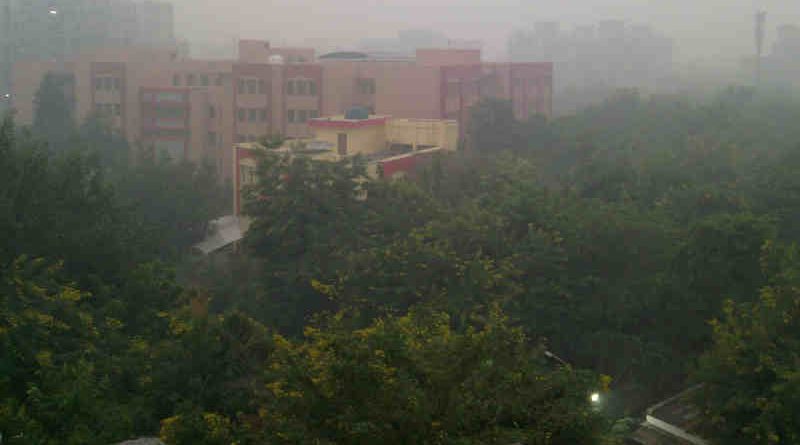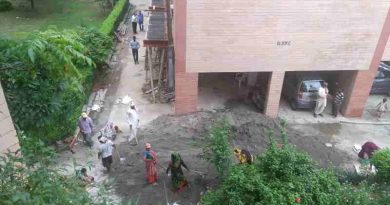Delhi Grapples with Escalating Pollution Nightmare: AQI Soars into Severe Territory as AI Initiative Targets Hidden Death Toll

Delhi Grapples with Escalating Pollution Nightmare: AQI Soars into Severe Territory as AI Initiative Targets Hidden Death Toll
The Aether 360 project represents a glimmer of hope, using technology to demand the systemic changes long overdue in the fight for breathable air.
New Delhi | November 28, 2025
As thick smog continues to envelop India’s capital, Delhi’s air quality has plunged into dangerous territory, teetering on the edge of a full-blown health catastrophe. On Friday morning, the city’s overall Air Quality Index (AQI) registered at 384, firmly in the “very poor” category, with several areas crossing into “severe” levels above 400. This sharp decline comes just days after authorities lifted stricter pollution controls under GRAP-III, underscoring the relentless grip of toxic air on the National Capital Region (NCR).
The crisis was starkly evident across monitoring stations, where 19 out of 39 sites reported “severe” pollution. Hotspots like Ashok Vihar (417), Bawana (414), Anand Vihar (411), Chandni Chowk (407), Narela (407), Burari (402), Aya Nagar (402), and JLN Stadium (401) bore the brunt, shrouded in hazardous haze. Even landmarks such as the All India Institute of Medical Sciences (AIIMS) were blanketed in smog, with an AQI of 401. Other areas, including ITO (396), IGI Airport (360), Alipur (355), and Najafgarh (361), hovered in the upper “very poor” range. Delhi has endured poor air quality for two straight weeks, with forecasts predicting it will oscillate between “very poor” and “severe” for the next several days.
The pollution spillover affected neighboring NCR cities as well. Noida stood out in the “severe” category, with readings at Sector 116 (438), Sector 125 (422), and Sector 1 (405). Greater Noida (380) and Ghaziabad (351) remained “very poor,” though Loni in Ghaziabad spiked to 425. Gurugram (318) and Faridabad offered slight relief but were still far from safe.
RELATED RMN NEWS REPORTS
[ One in Seven Deaths: AI Aims to Prove Air Pollution is Delhi’s Top Killer ]
[ Delhi’s Air Has Reached a Crisis Point — And the Cost Is Our Health ]
[ FAR Construction Causing Mayhem in Delhi Housing Societies ]
[ Stop Lethal FAR Construction, Corruption, and Pollution in Delhi ]
This acute episode highlights a far graver, persistent threat: air pollution as Delhi’s deadliest silent killer. According to a recent analysis of Global Burden of Disease (GBD) data by the Centre for Research on Energy and Clean Air (CREA), toxic air now accounts for nearly 15% of all deaths in the city—surpassing high blood pressure (12.5%) and diabetes (9%). In 2023 alone, long-term exposure to fine particulate matter (PM2.5) was linked to an estimated 17,188 fatalities, equating to one in every seven deaths. These microscopic PM2.5 particles infiltrate the bloodstream upon inhalation, disrupting oxygen flow and precipitating fatal conditions like heart attacks and strokes.
Contrary to popular blame on seasonal stubble burning from nearby states—which contributed less than 6% to PM2.5 levels in October—Delhi’s pollution stems from year-round local sources, with vehicles responsible for nearly half of emissions. Yet, a troubling policy impasse persists. The Union Environment Ministry insists there’s “no conclusive evidence” tying air pollution directly to deaths, a stance CREA counters by urging a shift to viewing it as a core public health crisis rather than merely an environmental one.
In a bid to shatter this denial and foster accountability, journalist and activist Rakesh Raman has introduced Aether 360, a pioneering AI-driven project. This self-funded initiative aims to build the world’s first AI model to compute an “Attribution Rate” (A-Rate), quantifying the probability that a patient’s hospital admission for respiratory or cardiac issues stems directly from recent pollution spikes. Using Explainable AI (XAI), it establishes a “Pollution Probability Link” (PPL) between real-time air data and anonymized health records. Success hinges on collaborations with institutions like AIIMS, UNEP, or WHO to validate the model with actual data, potentially revolutionizing policy by providing irrefutable, localized evidence of pollution’s lethal impact.
As Delhi residents choke under this dual assault of immediate smog and chronic toxicity, experts warn that without urgent, evidence-based interventions, the human cost will only mount. The Aether 360 project represents a glimmer of hope, using technology to demand the systemic changes long overdue in the fight for breathable air.
💛 Support Independent Journalism
If you find RMN News useful, please consider supporting us.




